Potent Trackhawk becomes ultimate Jeep
By John Gilbert
Maybe it’s time for the auto industry come up with a new and different name for such superlatives as “mind-blowing.” If you look over the vehicles from Dodge and its amazing SRT — Sport and Racing Technology — operation, you can review the assortment of available mind-blowing powertrains that can be obtained in such sporty vehicles as the Charger sedan and Challenger sports coupe.
Starting with the quite impressive 3.6-liter V6 with 305 horsepower, you can move up to the 5.7-liter Hemi V8 with 372 horsepower/400 foot-pounds of torque, to the 485 horse, 475 torque figures of the 6.4-liter Hemi, and then you can go onward and upward to the Hellcat’s 6.2-liter supercharged V8 and its 707 horse, 650 foot-poiund Hemi. Dizzying as that array might be, up on top there is the limited-edition Challenger Demon, with an even more potent version of the 6.2, with 808 to 840 horsepower and up to 770 foot-pounds.
Mind-blowing, to say the least.
But now we do have a new term to gather such superlatives, staying within the FCA (Fiat Chrysler Auto) family: “Trackhawk.”
The 2018 Jeep Grand Cherokee Trackhawk, to be exact.
We are accustomed to the most rugged Jeep models earning the designation “Trailhawk,” for capability over and above the garden-variety Jeeps whenever you venture off-road, but the Trackhawk is for when you stay on the road and want to have the strongest, fastest, most powerful SUV ever constructed — or even imagined.
Basically, the SRT guys, who performed such amazing engineering feats on the Hemi V8s for the Hellcats and Demons, took the 6.2-liter Hellcat Hemi V8 and performed even more magic tricks to turn the Grand Cherokee into the Trackhawk. When finished, the Trackhawk is a no-compromise street-road-track and, yes, off-road and foul-weather SUV weighs in at 5,500 pounds.
With all that heft, the Hellcat’s modified drivetrain can, indeed, function in something beyond the Charger or Challenger. It can send the Grand Cherokee Trackhawk 0-60 in 3.5 seconds, and covers the quarter-mile in 11.6 seconds, with a top speed of something over 180 miles per hour.
For such a hefty vehicle to drive “light” and corner flat, greatly revised suspension with adaptive Bilstein shocks was necessary. And an altered 8-speed TorqueFlite 8-speed automatic transmission, designed to get all that power to the ground via Pirelli tires either for track-duty or all-season.
Naturally, such enormous capability and performance costs a lot, to offset the enormous engineering effort and technical building alterations required. The Trackhawk has a base price of $85,900. As tested, one of the Trackhawks my driving partner and I drove on the roadways from Maine to New Hampshire listed at $94,970, in bright white; the “Redline 2” model with premium leather, top audio and panoramic sunroof listed at $100,980.
Yes, a Jeep for over $100,000 may be more than just mind-blowing, but the Trackhawk earns its sticker price with a quite-astonishing array of real-world parts and the coordination of such parts.
In the real world, people need to be able to drive moderately, even in snow, and sometimes they need to tow a trailer. The Trackhawk takes care of all such extremes, with a 7,200-pound towing capability, and console-switch controllable drive modes that can alter the all-wheel-drive system to your desires.
For example, the “automatic” setting adapts like a normal Grand Cherokee, with a torque split measuring 40 percent front/60 percent rear. If you switch to “sport,” the vehicle changes to a more enthusiast mode, with 50-percent reduced shift times, tightened suspension, firmed-up steering, enabled steering-wheel paddle shifters, and a 35-front/65-rear torque split.
Switch to “track” and transmission shift times are reduced 68 percent from the auto setting to 160 milliseconds, and the four-wheel drive, suspension firmness, stability control and steering convert to ultimate track performance, with a 30/70 front/rear torque split.
If you are passing up a trip to the track in exchange for hauling a fishing boat, you switch to “tow” and the torque delivery becomes more moderate with better smoothness and suspension settings combat pitch and yaw, while the power switches to a 60-percent front/40-percent rear dispersal.
Those of us in the Great White North will most appreciate the “snow” setting, which maximizes traction with reduced engine power and a 50/50 torque split.
If that isn’t enough, there is a “custom” mode that allows selecting favored settings for the various elements to create a customized combination.
With all that designed to go, the Grand Cherokee Trackhawk will also stop with remarkable suddenness and smoothness with a large Brembo braking system, with bright yellow calipers shining through those lightweight black alloy wheels, hauling down the Trackhawk in only 114 feet from 60 mph.
When Jeep first produced a high-powered Grand Cherokee, we got to drive it across Texas Hill Country from Austin to the Circuit of the Americas, the road-racing course that now houses the U.S. Grand Prix Formula 1 race. This time we drove from Portland, Maine, on some wonderfully curvy rural highways to Club Motorsports, a new road-racing facility near Ossipee, N.H.
While the track wasn’t yet open for public operation, it is the same course where I got to give the Challenger GT all-wheel-drive its first drive in ice and snow conditions. We only used a small part of the track back in late winter, but this time we were turned loose on the whole 2.5-mile track, which has 15 turns and a stunning 250 feet of elevation changes, including 14-percent grades on some of the hills.
Course officials had set out some rows of cones to guide us where to turn in at some locations, and Jeep arranged for some drivers familiar with the course to ride along with the media types.
Like the Hellcat and Demon, the Trackhawk includes changeabi
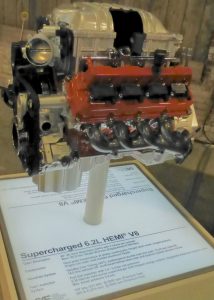
Trackhawk’s 6.2-liter Hemi V8 is a marvel of strengthening and elevating technology to 707 horsepower.
nstruments, with one selection letting you set it to launch control. With this engaged, you can run the revs up to near ear-splitting, and the car won’t move as a dashboard timer counts down 5-4-3-2-. When you go, the thrust is incredible, pushing you back in the firm bucket seat. Transmission, fuel feed and all systems await the precise time to launch and when you do, the instruments measure your 0-30, 0-60, quarter-mile and any other time-span you set, and it even measures your reaction time.
Lest anyone think the Trackhawk is a toy, it isn’t. It just happens to incorporate all the necessities of real-world drag racing, with all the parts reinforced and coordinated. The engine block, pistons, crankshaft, connecting rods, cylinder heads, exhaust valves, supercharger with electronic bypass and charge-air coolers — everything is designed for all-out performance.
The Trackhawk does not give you foglights, because where the foglights are on the other Grand Cherokees, the Trackhawk has air intakes to serve the engine and supercharger. None of that intrudes on the tried-and-true Jeep characteristics such as Quadra-Trac on-demand four-wheel drive with electronic limited-slip rear differential and a full-time active transfer case — all of which, including the rear differential, are reinforced and upgraded to extreme performance standards.
The full suite of safety items, such as adaptive cruise control with auto-stop, advanced brake assist, blind-spot monitoring and rear cross detection, forward collision warning and mitigation, front and rear park assist, lane departure warning and ready-alert braking are incorporated to make the Trackhawk either the safest all-out performer, or the highest-performing safety vehicle. It also, of course, includes the latest connectivity stuff like Apple CarPlay or Android Auto, as well as UConnect and 8.4-inch display with touchscreen, and roadside assistance.
On top of all that, the Trackhawk appearance is eye-catching, with its stance and aggressive demeanor given subtle but definite hints, such as the quad tailpipes, and the special wheels. For those uncompromising souls who want the baddest SUV in the world, the Trackhawk is the only prospect. Or maybe you’re just a normal person who won’t ever approach a race track, but have an incurable desire to tow a 7,200-pound trailer…really fast.


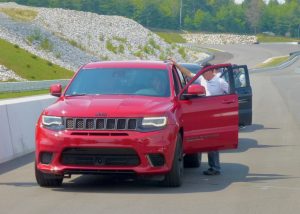
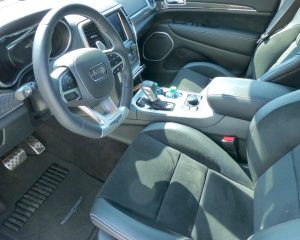
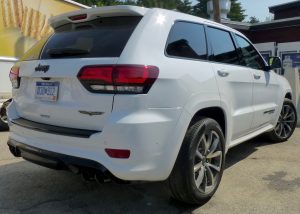
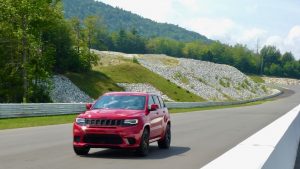
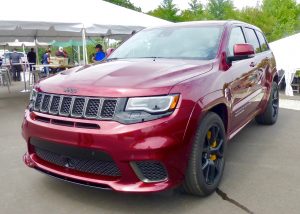
 John Gilbert is a lifetime Minnesotan and career journalist, specializing in cars and sports during and since spending 30 years at the Minneapolis Tribune, now the Star Tribune. More recently, he has continued translating the high-tech world of autos and sharing his passionate insights as a freelance writer/photographer/broadcaster. A member of the prestigious North American Car and Truck of the Year jury since 1993. John can be heard Monday-Friday from 9-11am on 610 KDAL(www.kdal610.com) on the "John Gilbert Show," and writes a column in the Duluth Reader.
John Gilbert is a lifetime Minnesotan and career journalist, specializing in cars and sports during and since spending 30 years at the Minneapolis Tribune, now the Star Tribune. More recently, he has continued translating the high-tech world of autos and sharing his passionate insights as a freelance writer/photographer/broadcaster. A member of the prestigious North American Car and Truck of the Year jury since 1993. John can be heard Monday-Friday from 9-11am on 610 KDAL(www.kdal610.com) on the "John Gilbert Show," and writes a column in the Duluth Reader.